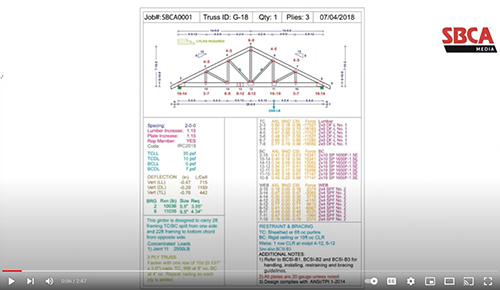Video Series: Understanding TDD Header Information
Originally Published by: SBCA Magazine — November 21, 2023
SBCA appreciates your input; please email us if you have any comments or corrections to this article.
To help individuals read and understand Truss Design Drawings (TDDs), SBCA has created a library of brief yet comprehensive videos called, “How to Read Truss Design Drawings.” The goal of this video series is to explore the various aspects of TDDs and give context to explain why the information is important.
TDDs are generated by the proprietary design software used by a component manufacturer (CM), so the exact layout of a TDD may vary slightly between software providers, but the same information is included regardless.
The first video of the series, “Truss Design Drawing Overview,” reviews the information contained in the header at the top of the TDD. From left to right, there is typically a job number, a truss ID, quantity, plies, and one or more dates.
The video explains what a job number and a truss ID are, how they are related to the truss depicted in the TDD, and how this information is related to a truss placement plan. The number of plies is important in calling out whether it is a single-ply truss, or a multi-ply girder that will need to be fastened together either in the manufacturing facility or on the jobsite.
Finally, the date section of a TDD may include one or more dates that correspond to when the engineering analysis was conducted, when the TDD was printed, and/or when the truss was manufactured.

